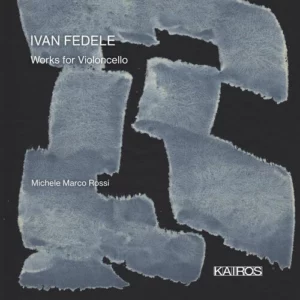Ivan Fedele
Works for Violoncello
Michele Marco Rossi, cello; Francesco Abbrescia, electronics
Kairos CD
Ivan Fedele (b. 1953) has created a large catalog of compositions. Like J.S. Bach, he has written six French suites, “Suite Francese.” Unlike Bach, Fedele’s six suites are for different instruments. His latest recording on the Kairos label focuses on the suites for cello, a solo Partita, and a reworking of Suite Francese VI that incorporates electronics.
Suite VI uses traditional baroque dances as movement titles, further underscoring the question: how closely related are Fedele’s pieces to their progenitors? It is a similar problem to considering the movements from Schoenberg’s Op. 25 Suite, and in both cases, any incorporation of baroque dance rhythms is, at best, greatly sublimated. Within these modern takes on the suite however, there are rhythmic and textural distinctions between movements that suggest that they are indeed organized as a set of variations.
The opening “Preludio” features trilled passages and ascending chromatic scalar segments, offset by rhythmically punctuated bass notes. “Ostinato” has a middle register melody that, rather than remaining unvaried, throughout the movement enlarges and collapses. “Corrente 1” features driving rhythms and squalls of sound effects against an occasionally present motive built out of minor seconds and minor thirds. Partway through, a huge build up of repeated notes arrives in a series of bass notes, giving the sense of an interior structural boundary. The bass register is then used as an ostinato with periodic interruptive soprano register squalls. The minor second theme once again makes appearances set against thrumming bass. The upper register is reasserted with a flurry of activity, juxtaposed against lower register glissandos. Those glissandos populate the final section, alongside minor seconds, now in the bass register. “Interludio” is a duet between a plummy tenor register melody and high harmonics. The eventual imposition of a bass line makes it conclude as a trio. “Corrente 2” is rife with combative repeated notes bounced from register to register. Upper register interjections harry the main rhetorical thread, which is a repeated move towards descent to the bottom of the instrument. Chords replace the upper voice and a longer bass melody is introduced and then swiftly deconstructed. Pizzicatos and bow pressure treat a melody that soars to the soprano register. This stentorian climax is just as swiftly replaced by hushed effects to close. The suite is an impressively varied piece in terms of techniques employed, expressive qualities, and ways in which relatively brief movements are given intricate formal identities.
Suite III has a different character at the outset of its first movement, “Arc-En-Ciel” with gently juxtaposed harmonics crafting a gradual move towards open strings and octaves that grounds the harmony between sliding tones. The harmonic series is presented successively in harmonics and open strings, finishing the movement with a sense of tonicization. “Preludio e Ciaccona” contrasts this with reedy thematic cells spiraling away, finally supplanted by open low strings and bass register slides. “Branle Double” contrasts this by starting in the upper register and moving through chromatic descents that land on dissonant multi-stops. Partway through, things are halted by bass octaves. The chromatic descents are now replicated in mid-range octaves. Angular and rangy melodic material is given an ardorous presentation. The piece gradually quickens, adding harmonics and bass notes to the line to create a compound melody. Here as elsewhere, cellist Michele Marco Rossi supplies a detailed, embodied, and expressive interpretation of Fedele’s music.
All of the pieces employ extended techniques, but Partita is a showcase for them. Instead of dances as movement titles, here we are given a bit more of a hint of generative properties for some – “X-Waves” and “Z-Point” – and moods for others – “Hommagesquisse” and “Threnos.” The latter title speaks to an overarching sense of keening and frequent violent utterances. The use of slow-moving glissandos imparts a vocality to the playing that underscores the sense of mourning. The final movement, “Corrente,” adds percussive raps and slaps alongside mercurial melodic playing that is embellished with high harmonics. There is a slight sense of triple meter that is one of the most palpable places related to dance.
The revised version of Suite VI, Suite VIb, incorporates electronics. It would be interesting to know whether Fedele had this in mind before composing the original version. There is certainly ample room left for the treatments employed, most of them effects that embellish the existing music. Harmonics are enhanced, repeated passages reverberate to create a sense of overlap, the gestures that result taking on the perception of a “super instrument.” Overdoubling and squealing treble register climaxes replace considerations of the baroque suite with ones of deformation and deconstruction. It is an impressive example of reconstituting an acoustic work in the digital domain. Which to prefer? Best not to have to choose. Recommended.
-Christian Carey

